advertisement

WGA Africa Summit
Tackling glaucoma in Sub-Saharan Africa
What are the main barriers to glaucoma care in Sub-Saharan Africa?

by Olusola Olawoye
Introduction
Glaucoma is a huge problem in Sub-Saharan Africa (SSA). It affects Africans on a scale unparalleled in most of the world. Africa is disproportionately affected by blindness with glaucoma accounting for 15% of blindness compared to 8% in the world.1 Reported prevalence of glaucoma in population-based studies within SSA ranges from 5.3% among South African blacks,2 to as high as 6.9% in Nigeria, West Africa.3 Glaucoma presents at an earlier age in blacks. Reported prevalence was 3.7% among subjects between 40–49 years in the Tema Eye Study in Ghana.4 Glaucoma in blacks is rapidly progressive, very aggressive and it is often associated with very high intraocular pressures (IOP). The high prevalence, early onset and aggressive course of the disease present a high rate of glaucoma blindness.
There are several barriers to glaucoma care in SSA. Firstly, most of the countries in SSA are less developed, with a low living standard, and low human development index relative to other countries. There are very few ophthalmologists with a ratio of 1:1,000,000 population in many countries in SSA; most of them work in the cities and patients have to travel long distances to get care.
There is gross inadequacy of infrastructure and ophthalmic equipment in many centers. The diagnosis of glaucoma even among the few ophthalmologists is mainly based on disc findings and intraocular pressure. This presents a peculiar problem because studies have shown that blacks also have larger disc diameters and cupping, with thinner corneas, therefore many patients will be labeled normal based on a ‘normal IOP’. Moreover, there are no simple guidelines for diagnosis and management in these low resource settings.
Medical management of glaucoma is impractical and rarely successful in most of SSA. The high cost of anti-glaucoma medications, the need for regular follow-up, and unavailability of the drugs worsens compliance which is an important factor in delaying progression in glaucoma management. In cities where medications are available there are no guarantees of the authenticity and potency of the drugs at time of purchase since regular electricity is scarce in most of SSA. Trabeculectomy has poor success rates in blacks. Very few centers have laser machines for trabeculoplasties and glaucoma drainage devices are very expensive and not readily available. In conclusion, the barriers to glaucoma care in SSA seem enormous, but they can be tackled with concerted effort by relevant government agencies, non-governmental organizations and international collaborations.
References
- Resnikoff S, Pascolini D, Etya’ale D, et al. Global data on visual impairment in the year 2002. Bull World Health Organ 2004;82:844-851.
- Rotchford AP, Kirwan JF, Muller MA, Johnson GJ, Roux P. Temba Glaucoma Study: a population-based cross-sectional survey in urban South Africa. Ophthalmology 2003;110:376-382.
- Ashaye A, Ashaolu O, Komolafe O, et al. Prevalence and types of glaucoma among an indigenous African population in southwestern Nigeria. Invest Ophthalmol Vis Sci 2013;54:7410-7416.
- Budenz DL, Barton K, Whiteside-de Vos J, et al. Prevalence of glaucoma in an urban West African population: The Tema Eye Survey. JAMA Ophthalmol 2013;131:651-658.

African Initative Presentation
by Keith Martin
Glaucoma accounts for approximately 15% of blindness in sub-Saharan Africa (SSA), the highest proportion in the world. The large majority of affected cases have open-angle glaucoma which is often aggressive and early onset in life. People with glaucoma often present late with advanced visual loss and there is poor awareness of the disease in many local communities.
The risk of blindness due to glaucoma in Africa is affected by many factors including the age of onset of the disease and its natural history, access to diagnostic facilities prior to severe visual loss, access to high-quality treatment services, availability of medical and surgical treatments, and adherence to treatment and follow-up. Most countries in SSA have inadequate numbers of trained personnel to provide glaucoma care to those in need. Many countries also have multiple geographic and socio-economic issues that make effective glaucoma care even more challenging.
The International Agency for the Prevention of Blindness has identified key objectives for implementation of WHO Global Action Plan:
- Generating evidence of the clinical needs, e.g. rapid assessments of avoidable blindness;
- Integrating eye health policies, plans and programs;
- Multi-sectoral engagement and effective partnerships.
As an example of an ongoing partnership, Addenbrooke’s Abroad from the UK has been working in Botswana for over five years on a variety of eye-health programs, with exchanges of staff in both directions occurring on a regular basis. Recent rapid assessments of avoidable blindness in Botswana found that 23% of blindness in the country was due to glaucoma. Addenbrooke’s Abroad personnel have worked together with the Botswanan Ministry of Health and multiple local and overseas stakeholders to develop a National Eye Care Action Plan 2015-2019. The plan sets out a detailed series of achievable steps required to reduce the magnitude of visual impairment in the country from 50,000 to less than 35,000 and to reduce the magnitude of blindness from 15,000 to less than 10,000. Improving glaucoma care has been incorporated into the plan as a key priority and current work is ongoing to standardize assessment procedures in local clinics, improve training of ophthalmic nurses, streamline referral processes and establish weekly glaucoma patients in the two major hospitals with access to modern laser and surgical facilities.
Although the population of Botswana is small, the challenges faced are similar to many other countries in achieving such improvements. The project has also highlighted that such multinational partnerships bring great benefits to all participants.

The problem and magnitude of blindness from glaucoma in Sub-Saharan Africa
by Neeru Gupta
In 2010, the World Health Organization estimated that of the 39 million people blind worldwide, glaucoma accounts for 8%.1 By 2040, of the 111.8 million people projected to have glaucoma globally, 19.2 million will be in Africa.2 Compared to the rest of the world, Sub-Saharan Africa has the greatest poverty, and the highest prevalence of glaucoma, with up to a third of blindness due to glaucoma.3
In African populations, glaucoma tends to start earlier and in one study, one third of patients presented younger than 40 years.4 It is estimated that one half of patients with glaucoma remain undiagnosed,5 however in Africa, this number may be as high as 97%.6 For those identified as having the disease, glaucoma care may be difficult due to treatment rejection, poor compliance, and lack of education and awareness.7 By the time patients present, many have lost significant vision. In a Nigerian study of newly-diagnosed patients, 50% and 74% were bilaterally blind by visual acuity, and visual field criteria, respectively.8
The problem of glaucoma in Sub-Saharan Africa is staggering. The significant visual disability at initial presentation, younger age of onset, aggressive nature of the disease, lack of awareness, and resistance to interventions seem overwhelming. Inability to pay for care is a major barrier to treatment. Other systemic hurdles to glaucoma care include the striking lack of ophthalmologists with only one ophthalmologist per million people in urban regions, and one per seven million people in rural areas.9 Distance from healthcare facilities, advanced disease presentation and facilities with insufficient medical professionals and equipment, all add to the difficulty in treating glaucoma. The lack of glaucoma education contributes to delayed presentation and increased likelihood of blindness. There is a strong need to support educational, human resource, financial and infrastructure needs to link and integrate glaucoma services to comprehensive eye care programs. Long-term efforts are required to reduce human and societal costs of glaucoma blindness in Sub-Saharan Africa.
References
- World Health Organization. Universal Eye Health: A Global Action Plan 2014-2019. Geneva, Switzerland: WHO; 2013. Available at: www.who.int/blindness/actionplan/en
- Tham YC, et al. Global prevalence of glaucoma and projections of glaucoma burden through 2040: a systematic review and meta-analysis. Ophthalmology 2014;121(11):2081- 2090. doi:10.1016/j.ophtha.2014.05.013
- Cook C. Glaucoma in Africa: size of the problem and possible solutions. J Glaucoma 2009;18:124-128. doi:10.1097/IJG.0b013e318189158c
- Enock ME, Omoti AE, Momoh RO. Glaucoma in a suburban tertiary care hospital in Nigeria. J Ophthal Vis Res 2010;5:87-91.
- Tielsch JM, et al. Racial variations in the prevalence of primary open-angle glaucoma. The Baltimore Eye Survey. Jama 1991;266:369-374.
- Budenz DL, et al. Prevalence of glaucoma in an urban West African population: the Tema Eye Survey. JAMA Ophthalmol 2013;131:651-658. doi:10.1001/jamaophthalmol.2013.1686
- Mbadugha CA, Onakoya AO. The awareness, perceptions and experiences of primary open angle glaucoma patients in Lagos Nigeria. Scientific Reports 2014;4. doi:10.1038/ srep07585
- Awoyesuku EA, Ejimadu CS. Visual disability in newly diagnosed primary open angle glaucoma patients in a tertiary hospital in Nigeria. Nigerian J Med 2012;21:78-80.
- Sommer A. Global access to eye care. Arch Ophthalmol 2007;125:399-400. doi:10.1001/ archopht.125.3.399
WGA Educational Portal Videos
Watch the following videos shot at WGC-2015, free of charge, via the WGA Educational Portal.
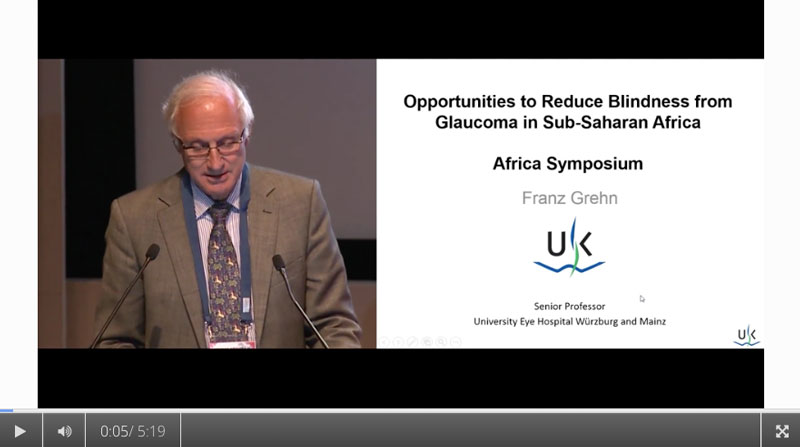
Franz Grehn
Tackling Glaucoma
in Sub-Saharan Africa
OOpportunities to Reduce Blindness from Glaucoma in Sub-Saharan Africa
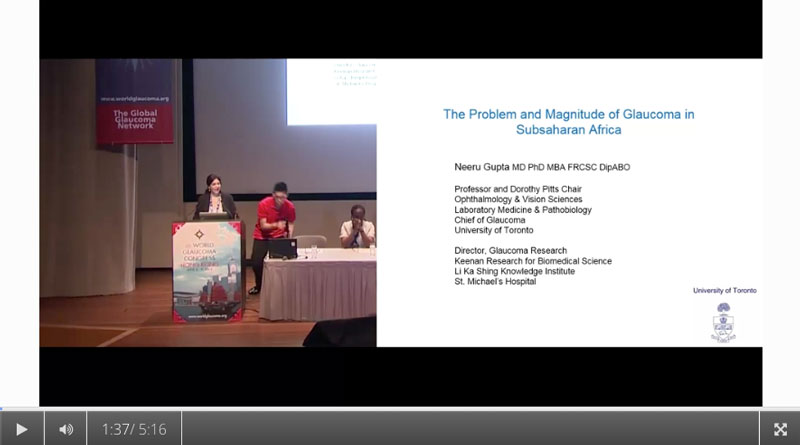
Neeru Gupta
Tackling Glaucoma in Sub-Saharan Africa
The Problem & Magnitude of Blindness from Glaucoma in Sub-Saharan Africa

Keith Martin
Tackling Glaucoma in Sub-Saharan Africa
Clinical Characteristics of Glaucoma and Management Challenges
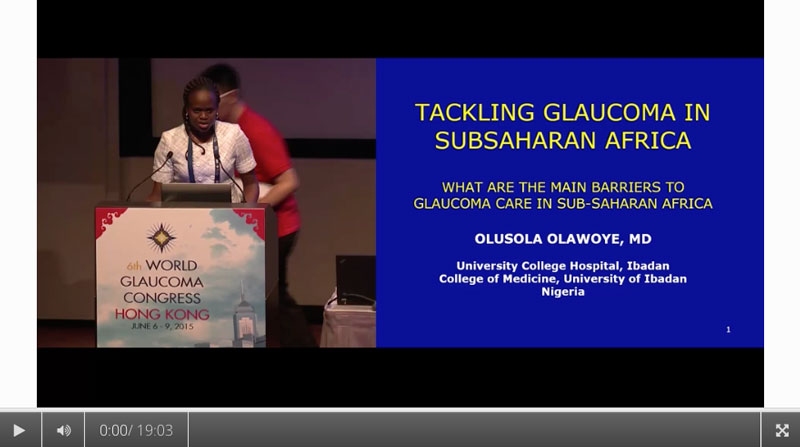
Olusola Olawoye
Tackling Glaucoma in Sub-Saharan Africa
What are the Main Barriers to Glaucoma Care?
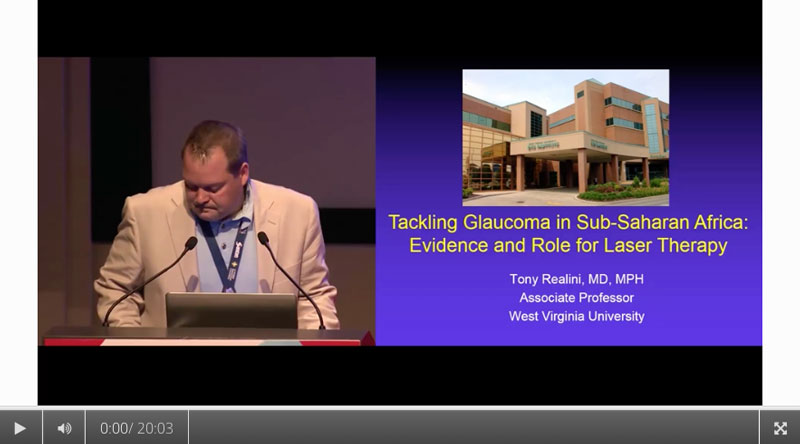
Tony Realini
Tackling Glaucoma in Sub-Saharan Africa
Evidence and Role for Laser Treatment
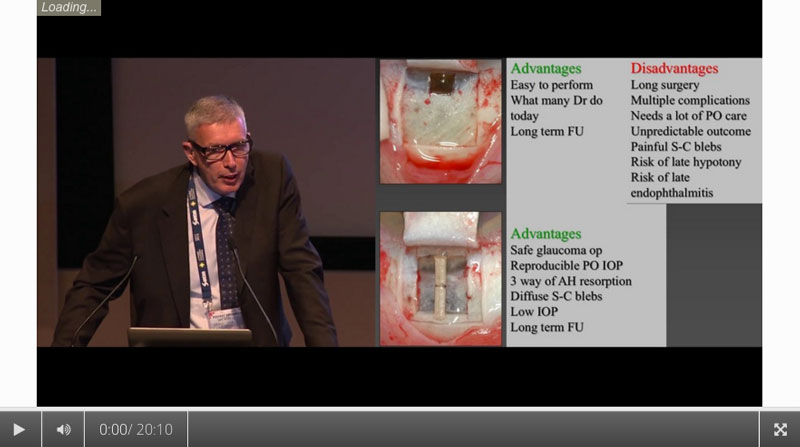
Andre Mermoud
Tackling Glaucoma in Sub-Saharan Africa
Surgical Approaches and Unique Considerations

